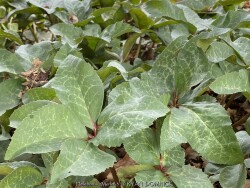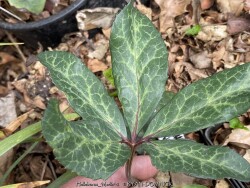




Plant Min Zone: 4b
Plant Max Zone: 8a
Sunlight: Part Sun, Shade, Deep Shade
Water / Rainfall: Low, Average
Soil Quality: Average, Rich
Bloom Season: Winter, Early Spring
Flower Color: Pink
Berry / Fruit Color: Green
Spring Foliage Color: Dark Green
Summer Foliage Color: Dark Green
Fall Foliage Color: Dark Green
Evergreen Foliage: Yes
Winter Interest: Yes
Scented Flowers: No
Drought Tolerance: Medium, High
Wet-Feet Tolerance: Low
Humidity Tolerance: Medium
Wind Tolerance: Medium
Poor Soil Tolerance: Rocky Soils, Sandy Soils, Alkaline Soils (high PH)
Height: 0.75' - 1'
Width: 1' - 1.5'
Growth Rate: Slow
Service Life: Very Long: 10-20 years
Maintenance Need: Low
Spreading Potential: Low
Yearly Trimming Tips: Trim Perennial to Ground in Early Spring before New Growth: Has Winter Interest.
Plant Grouping Size: Small Grouping of 3-5, Medium Grouping of 5-10, Mass Planting of 10 or more
Best Side of House: East Exposure, North Exposure
Extreme Planting Locations: Root-Bound Soils Under Tree, Survives Severe Drought, Top of Retaining Wall Locations
Ornamental Features: Long Lasting Fall Color, Bright Winter Color, Emerges Early in Spring, Multiple Seasons of Interest, Exceptional / Colorful Foliage
Special Landscape Uses: Groundcover
Possible Pest Problems: Stem/Crown Disease
Plant Limitations: May be Poisonous, Needs Excellent Drainage, May get Occasional Winter-kill
Lenten Rose (Helleborus) is the ultimate dry-shade plant for eastern Kansas landscapes. Most hellebores are native to mountainous wooded regions of Europe with limestone bedrock and calcareous, humus-rich soils. They have everything a gardener might ask for; beautiful spring flowers, dependable dark green foliage, evergreen during winter, appreciation for alkaline soils, and ease of care with very low maintenance. Hellebores are one of the first perennials to start growing in the spring with flowering occurring even with hard freezes. Flowers last incredibly long 2 to 3 months and finally turn greenish in June. No deadheading is needed because the foliage just absorbs the flower stalks as they fade. Summer and fall foliage is dark green, dependable, and pest-free. Evergreen foliage is hardy to about 0°F. If it gets colder than that, hellebores will be deciduous with no detrimental effects. Desirable self-seeding may gently occur around mother plants. Hellebores do have an Achilles heel however; they cannot tolerate wet or poorly drained soils, not even slightly. In areas with too much rainfall or poorly drained soils, foliage diseases and root rot are likely to occur. Hellebores are also not the best choice for full sun, while they will survive, they will get foliage burn in the summer when over 100°F in afternoon sun. With poisonous foliage, these plants resist deer and rabbit browsing. What a great plant for the dry shade garden! There are many improved flowering cultivars to choose from now. Merlin Pink Hellebore (Helleborus x ballardiae HGC 'Merlin') features large outward-facing pink flowers that last 6-8 weeks. Prominent veining on leathery evergreen foliage is showy even when not in bloom.